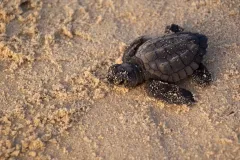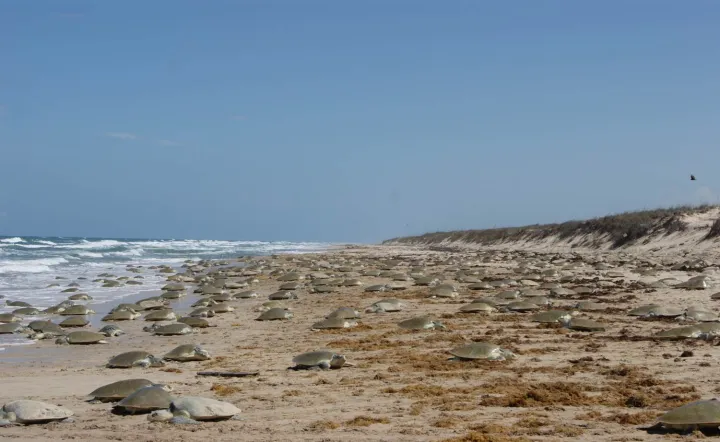Taking the Temperature of the Kemp's Ridley Sea Turtle

The Kemp’s ridley is a “riddler” among sea turtles. Although the species was initially recognized in 1880, scientists didn't know where it nested until 80 years later, when a film documenting about 40,000 Kemp’s ridley turtles nesting on a single day in Rancho Nuevo, Mexico was discovered. These massive, simultaneous nesting events or “arribadas” (meaning “arrival by sea” in Spanish) are spectacular to see and essential to observe for keeping track of the number of sea turtle nests. But they pose a challenge to scientists, who have to be in the right place at the right time to study them. By the time their nesting location was discovered, the Kemp’s ridley population was already plummeting towards extinction. It reached a perilously low point in the mid 1980’s for two main reasons: long-standing egg harvesting and a growing commercial shrimp industry whose nets can drown turtles that get accidentally entangled.
Conservation measures have been put in place over the last five decades to bring the species back from the brink of extinction. Nesting females are now protected by U.S. and Mexican laws, and all nests are relocated to the safety of egg hatcheries, away from the reach of poachers and predators. At sea, fishermen have added escape hatches (called Turtle Excluder Devices) to their nets to reduce accidental bycatch of the Kemp’s ridley. These efforts worked: The population began to climb in the early 1990’s, and by 2009 had reached more than 21,000 nesting females, up from about 200 throughout the 1980’s.
Another major effort that aided in pulling the ridley back from extinction was a focus on increasing the number of nests at Rancho Nuevo by increasing the number of female young—future mothers. The sex of a sea turtle embryo is determined not by sex chromosomes, but by the temperature of the nest where the egg incubates: males develop in cooler temperatures and females in warmer temperatures. Knowing this, conservationists were able to increase sand temperatures, and thus increase the number of female hatchlings, by adjusting the light and shade in the hatcheries. This ensured that a greater number of females returned to nest after they reached adulthood around 10 to 13 years later.
However, the recovery of the Kemp’s ridley has slowed and scientists are no longer seeing the 15 percent increase in the number of nests laid each year. In fact, the number of nests has leveled off at around 20,000 nests or even decreased in some years, such as in 2010 and 2013 when only 14,000 and 17,000 nests were recorded. Although severely cold temperatures and the Deepwater Horizon oil spill may have contributed to this decline, the causes remain unclear.
There may be more trouble ahead as both air and water temperatures increase with climate change. Though a small temperature increase (a tenth of a degree) simply increases the numbers of female hatchlings, larger increases such as those predicted for the future could lead to shifts in the timing of reproductive behavior, such as when the turtles migrate and nest. Extreme temperatures could also lead to a greater number of hatchling deaths in nests and fewer healthy hatchlings produced from the nesting beach.
But there is hope: using the data they've collected on nest temperatures, nest locations, and nest timing since 1998, scientists with the Mexican government (CONANP) and the University of Alabama at Birmingham (UAB) can try to prepare the turtles for a warmer future. By analyzing these 14 years of data, scientists will be able to visualize changes in nesting over time, and how they have affected the population's overall sex ratio. This information can help conservationists decide where egg hatcheries should be placed, whether they should be shaded or sprinkled with water to cool the sand, or whether hatcheries should even be used at all. Knowing where turtles have nested in the past can help scientists figure out where they might nest in the future, and therefore indicate where the greatest conservation efforts should be focused.
Through these long-term temperature and nesting databases, the Kemp’s ridley can serve as a valuable sentinel of ecosystem health. It could also be a key example of how climate change could affect other species with temperature-sensitive reproduction, such as other many other reptiles including other sea turtles. Instead of having yet another “riddle” up its sleeve for scientists to solve, perhaps our knowledge of the Kemp's ridley could help conserve other species in the face of climate change.


